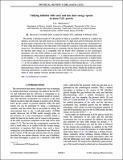Por favor, use este identificador para citar o enlazar a este item:
http://hdl.handle.net/10261/237563COMPARTIR / EXPORTAR:
 SHARE SHARE
 CORE
BASE CORE
BASE
|
|
| Visualizar otros formatos: MARC | Dublin Core | RDF | ORE | MODS | METS | DIDL | DATACITE | |

| Título: | Unifying inflation with early and late dark energy epochs in axion F(R) gravity |
Autor: | Oikonomou, Vasilis K. | Fecha de publicación: | 2021 | Editor: | American Physical Society | Citación: | Physical Review D 103(4): 044036 (2021) | Resumen: | We provide a theoretical model of F(R) gravity in which it is possible to describe in a unified way inflation, an early and a late dark energy era, in the presence of a light axion particle which plays the role of the dark matter component of the Universe. Particularly, the early time phenomenology is dominated by an R2 term, while the presence of the other terms f(R) ensure the occurrence of the early and late-time dark energy eras. The inflationary phenomenology is compatible with the Planck 2018 data for inflation, while the late-time dark energy era is compatible with the Planck 2018 constraints on the cosmological parameters. Also, the model exhibits an early dark energy era, at z∼2.5 approximately, followed by a deceleration era, which starts at approximately z∼1.5, which in turn is followed by a late-time dark energy era for redshifts z∼0.5, which lasts for approximately 5 billion years up to present time. A notable feature of our model is that the dark energy era is free from dark energy oscillations, at least in the redshift interval z=[0,10]. In addition, we also discuss several features related to observational data at z∼2.34, at which redshift intricate observational data exist in the literature. Moreover, the numerical code for the dark energy phenomenology, written in python3, is presented in the end of the article. Finally, the model has another interesting characteristic, a sudden jump of the value of the Hubble rate in the redshift interval z∼[2,2.6] where its value suddenly increases and then decreases until z∼0. | Versión del editor: | https://doi.org/10.1103/PhysRevD.103.044036 | URI: | http://hdl.handle.net/10261/237563 | DOI: | 10.1103/PhysRevD.103.044036 | E-ISSN: | 2470-0029 |
| Aparece en las colecciones: | (ICE) Artículos |
Ficheros en este ítem:
| Fichero | Descripción | Tamaño | Formato | |
|---|---|---|---|---|
| unifyaxi.pdf | 580,63 kB | Adobe PDF |  Visualizar/Abrir |
CORE Recommender
SCOPUSTM
Citations
96
checked on 06-abr-2024
WEB OF SCIENCETM
Citations
91
checked on 26-feb-2024
Page view(s)
53
checked on 19-abr-2024
Download(s)
164
checked on 19-abr-2024
Google ScholarTM
Check
Altmetric
Altmetric
Este item está licenciado bajo una Licencia Creative Commons

